Audi RS 6
The Audi RS 6 is a high-performance variant of the Audi A6 range, produced by the high-performance subsidiary company Audi Sport GmbH, for Audi AG, a division of the Volkswagen Group.
| Audi RS 6 quattro | |
|---|---|
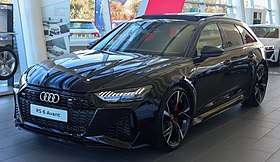 2020 Audi RS 6 Avant in Sebring Black | |
| Overview | |
| Manufacturer | Audi Sport GmbH, for Audi AG |
| Production | 2002–present |
| Assembly | Germany: Neckarsulm |
| Body and chassis | |
| Class | Executive car (E) |
| Layout | Front-engine, all-wheel-drive (quattro) |
| Platform | Volkswagen Group C platform series |
| Related | Audi A6 Audi S6 |
| Powertrain | |
| Transmission | Tiptronic automatic |
The first and second versions of the RS 6 were offered in both Avant and saloon forms. The third generation is only offered as an Avant.
Overview
The "RS" initials are taken from the German: RennSport – literally translated as "racing sport", and is Audi's ultimate 'top-tier' high-performance trim level, positioned a noticeable step above the "S" model specification level of Audi's regular model range line-up. Like all Audi "RS" models, the RS6 pioneers some of Audi's newest and most advanced engineering and technology, and so could be described as a halo vehicle, with the latest RS6 Performance having the equal most powerful internal combustion engine out of all Audi models, with the same horsepower and torque as the physically larger Audi S8 Plus. Unlike the A6 and S6, however, the RS6's engines in the C5 and C6 iterations have not been shared with any other vehicle in Audi's lineup. However, for the C7 generation, the Audi RS6 has the same 4.0L biturbo V8 engine as the Audi RS7, with both being positioned at the top of the Audi S and RS range, and detuned variants of the same engines are found in the Audi S8, Audi A8, and Audi S6.
Based on the A6 platform, the RS6's engines are front-mounted and longitudinally oriented, while the transmission is mounted immediately at the rear of the engine in a longitudinal orientation, in the form of a transaxle. Like all S and RS models, the RS6 is only available with Audi's 'trademark' Torsen-based quattro permanent four-wheel drive system.
The C5 RS6 was the fourth model to come out of Audi's private subsidiary company, "quattro GmbH". The first was the Audi RS2 Avant, from a joint venture between Porsche and quattro GmbH for the Audi marque. The second was the Audi C4 S6 Plus, produced from April 1996 to July 1997. Third was the 2000 Audi B5 RS4; the fifth was the 2005 Audi B7 A4 DTM Edition saloon, and the sixth was the 2006 Audi B7 RS4. The seventh and current (as of January 2010) quattro GmbH model is the latest Audi C6 RS 6.
Production of the original Audi C5 RS 6 began in June 2002 and ended in September 2004. The second and current Audi C6 RS 6 was introduced at the 2007 Frankfurt Motor Show. The original RS6 was the first Audi RS variant exported to North America, while the C6 RS6 is only sold in Europe.
Main rivals for the Audi RS 6 are the BMW M5 and Mercedes-Benz E55/E63 AMG.[1][2][3]
C5 (Typ 4B, 2002–2004)
| First generation (C5/4B) | |
|---|---|
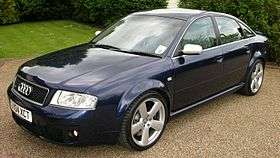 | |
| Overview | |
| Production | July 2002 – September 2004 |
| Body and chassis | |
| Body style | 5-door Avant (estate/wagon), 4-door saloon/sedan |
| Platform | Volkswagen Group C5 |
| Related | Audi C5 A6, Audi C5 S6 |
| Powertrain | |
| Engine | 4.2 L V8 40v DOHC 'biturbo' (BCY/BRV) |
| Transmission | 5-speed ZF 5HP24A tiptronic automatic |
| Dimensions | |
| Wheelbase | 2,759 mm (108.6 in) |
| Length | 4,852 mm (191.0 in) |
| Width | 1,850 mm (72.8 in) |
| Height | Saloon: 1,387–1,426 mm (54.6–56.1 in), Avant: 1,390–1,430 mm (54.7–56.3 in) |
| Kerb weight | Saloon: 1,840 kg (4,057 lb), Avant: 1,865 kg (4,112 lb) |
| Chronology | |
| Successor | C6 RS6 (Typ 4F) |
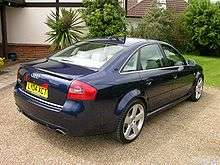

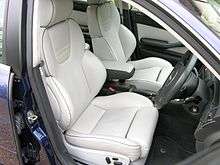
The original Audi C5 RS 6 quattro (Typ 4B) was the top-of-the-line user of the Volkswagen Group C5 platform (1997–2004), and was initially available as a five-door five-seat Avant - Audis name for an estate or station wagon. A four-door five-seat saloon/sedan followed shortly after the launch of the Avant. Derived from the Audi C5 S6 (itself derived from the Audi C5 A6), the RS6 also shares the aluminium structure from the firewall and forward with the C5 A6s with V8 engines (A6 4.2 V8 quattro, S6 saloon/Avant). It was manufactured from July 2002 through to September 2004.
Official performance figures for the Avant, whilst consuming the recommended high octane 98 RON "Super Plus" unleaded petrol indicate the 0-100 kilometres per hour (62.1 mph) dash would be completed in 4.6 seconds (s), reaching 200 km/h (124.3 mph) in 22.8 seconds (22.6 s for the saloon). Official figures state an electronically limited top speed of 250 km/h (155.3 mph), although most "RS" owners report that the speed limiter is rather liberal on all RS cars, with genuine 'limited' top speeds of 270 km/h (167.8 mph) being possible to achieve. Using a lower octane-rated petrol, such as the standard 95 RON "Premium" unleaded will reduce the engine power output, and have logical reduction in performance.
Luggage capacity, measured according to the VDA block method in the Avant ranges from 455 litres (16.07 cu ft), to 1,590 litres (56.15 cu ft) with the rear seats folded down. For the saloon, the boot holds 424 litres (14.97 cu ft).
C5 powertrain
For the C5 RS6 powertrain detail, the engine is an all-aluminium alloy 4,172 cubic centimetres (254.6 cu in) twin-turbocharged ('biturbo'), double overhead camshaft, 5 valve per cylinder version of Audi's 4.2-litre 90° V8 petrol engine (parts code prefix: 077, identification code: BCY), developed and manufactured in Germany and the UK by quattro GmbH and Cosworth Technology (now known as MAHLE Powertrain). With the addition of the two turbochargers (one per cylinder bank), the power output of the V8 engine was increased to 331 kW (450 PS; 444 bhp) at 5,700 to 6,400 rpm, and generated 580 N⋅m (428 lbf⋅ft) of torque. The combination of the 4.2-litre V8, variable inlet valve timing, and twin turbochargers gave the RS6 an exceptionally wide power band, with peak torque available from 1,950 to 5,600 rpm.
Further detail of the engine includes fully sequential electronic multi-point fuel injection with intake manifold-sited fuel injectors,[4] mapped direct ignition system[5] with solid-state high voltage distribution using eight individual single-spark ignition coils and NGK longlife spark plugs, and three knock sensors. Engine management uses a Bosch Motronic[6] ME 7.1.1 engine control unit, which controls all functions of the engine operation; including fuel delivery, ignition system, valve timing, emissions control systems, and torque reduction control—the latter operating in conjunction with the Bosch ESP 5.7 Electronic Stability Programme, as part of the "Anti Slip Regulation" (ASR) traction control system. The engine is compliant with the European Union Euro3 (EU3) standard, and includes two close-coupled primary catalytic converters (CATs), two underfloor main CATs, and four heated oxygen sensors which manage the cylinder bank selective lambda control. This results in a CO2 emissions rating of 350 g/km for the Avant and saloon in standard configuration.
It has an electronically controlled five-speed ZF 5HP24A tiptronic automatic transmission (parts code prefix: 01L, identification code: GAG) (gear ratios—1st: 3.571, 2nd: 2.200, 3rd: 1.505, 4th: 1.000, 5th: 0.804), with lock-up torque converter in all forward gears. It has "hill detection" capability, and, despite many press articles stating that the gearbox was programmed to "blip" the throttle for downshift gear changes, no UK owners have ever found this feature to be present. The transmission control unit ECU incorporates "fuzzy logic" with its "Dynamic Shift Programme" (DSP), with the shift pattern adapting to suit individual driving styles. 'Tiptronic' manual control can be achieved with either the floor-mounted gear shift lever, or the steering wheel mounted 'paddles'.
The RS6 was only available with Audi's Torsen-based quattro permanent four-wheel drive, utilising the Torsen T-2 dynamic 'automatic torque biasing' (ATB) centre differential (diff), a modified unit which was being used in the 6.0-litre W12-powered Audi D3 A8. The torque from the engine is first routed from the gearbox output shaft to the Torsen centre diff, and then automatically divided and apportioned between the front and rear axles.
The front and rear axle differentials (ratio: 3.197, rear axle identification code: GGW) are a conventional "open" type, but utilise an "Electronic Differential Lock" (EDL). EDL is an integrated additional function of the Bosch Electronic Stability Programme (ESP) system, and works by monitoring and comparing the individual wheel speeds across an axle, and braking an individual wheel which is sensed to have lost traction (spinning), thus transferring torque across the axle to the wheel/tyre which does have grip. "Anti-Slip Regulation" (ASR), more commonly known as traction control system[7] completes the Bosch ESP-related driver aids.
C5 suspension and steering
Utilising the same fully independent four-link front suspension, and double wishbone rear, as its related A6 and S6, the RS6 was lowered by 20 millimetres (0.79 in), with a 30% stiffer spring rate, and 40% increased compression damping. The RS6 also served as the debut model for Audi's "Dynamic Ride Control" (DRC) system. The DRC system is mainly mechanical, and uses a pump to provide additional pressure to individual dampers (shock absorbers) during cornering, acceleration or braking; to counteract rolling and pitching. The system can adjust the stiffness at each individual damper constantly; to maintain both a comfortable ride on straight roads, and high level of poise and grip when cornering hard, accelerating, or braking. The DRC's main advantage is that it operates without the need for complicated electronics, as required in similar systems from Mercedes-Benz and other competitors. Its main drawback is that the DRC dampers have been known to fail (leaking fluid from the cross-linked circuits), which can affect the handling and ride quality of the vehicle; some owners have reported needing multiple replacements of faulty DRC units and many drivers have opted to replace the system with simpler and more reliable aftermarket coilover suspension.
C5 brakes, wheels and tyres
The front brakes feature fixed Brembo 8-piston monoblock brake calipers, working with radially vented and cross-drilled brake discs, sized at 365 millimetres (14.4 in) in diameter, by 34 mm (1.34 in) thick. The rear features single-piston floating ATE calipers with integrated cable-operated parking brake mechanism, mated to radially vented disc and cross-drilled, sized 335 mm (13.2 in) by 22 mm (0.87 in). Front and rear brake calipers are finished in a high-gloss black paint, with the fronts incorporating the Audi "RS" logo. Both front and rear discs are held in by metal pins to the lightweight disc hub, and allow 1.0 mm (0.039 in) of lateral thermal expansion from the hub centre.
Bosch ESP 5.7 Electronic Stability Programme,[8] with Anti-lock Braking System (ABS),[9] Electronic Brakeforce Distribution (EBD), and Brake Assist (BA) was standard fitment.
There were total of three original equipment manufacturer (OEM) wheel and tyre types produced for the RS6. In Europe and elsewhere, 19-inch wheels were standard, with an optional 18-inch package. In the U.S. market, the 18-inch package was the only available offering. An 18-inch winter package, with Dunlop SP Winter Sport M3 tyres (225/45 ZR18 95V) was universally available.
For 18-inch wheels, the standard tyre fitted was 255/40 ZR18 99Y XL with eXtraLoad (XL) rating. This is often stressed, and is the only recommendation by Audi, as RS6 does weigh 1,865 kg (4,112 lb). Tyres which are not rated XL are not safe (nor legal, in most countries) for use. Owners reported finding Continental ContiSportContact 2, Dunlop SP Sport 9000, Michelin Pilot Sport PS2, and Pirelli P-Zero Rosso as OEM suppliers for tyres on the RS6. However, according to ETKA, the Dunlop and Pirelli tyres were subsequently withdrawn from official supply, and the Continental SportContact 2 has been superseded by the SportContact 3. An additional tyre from Bridgestone has now been included as officially recommended fitment, the Potenza RE050A.
For 19-inch wheels, the standard tyre fitted was 255/35 ZR19 96Y XL. However, there were debates as to how safe 19-inch (48 cm) wheels and tyres are, as the XL rating achieves a 96 Load Index (710 kg (1,565 lb) load rating). In contrast, the 255/40 ZR18 XL will get you 99 Load Index, good for 775 kg (1,709 lb) per tyre. Current officially recommended tyres from ETKA for the 19-inch rims only include the Michelin Pilot Sport PS2, Continental ContiSportContact 3 and Vredestein Ultrac Sessanta also 96Y XL.
C5 RS6 Plus
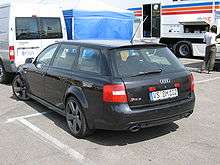
Between April 2004 and September 2004, there was a final limited run of an even higher-performance RS6, named the Audi RS6 Plus. This had an increased engine power output (identification code: BRV), and produced 353 kW (480 PS; 473 bhp) at 6,000-6,400 rpm, with the same 580 N⋅m (428 lb⋅ft) of torque at 1,950-6,000 rpm. This engine was also developed and manufactured in the UK by Cosworth Technology (now known as MAHLE Powertrain). The additional performance was achieved with a new engine control unit (ECU), and two additional coolant radiators behind the side-mounted intercoolers (these were standard fitment on the standard RS6 in hotter climate countries). Official performance figures indicate the discipline of sprinting from standstill to 100 km/h (62.1 mph) in 4.4 seconds. The RS6 Plus carries on to reach 200 km/h (124.3 mph) in 20.36 seconds, and has an official top speed of 280 km/h (174.0 mph).
The RS6 Plus came with Dynamic Ride Control (DRC) as standard, and also included a no-cost option of "Sports Suspension Plus", which lowered the standard sports suspension by a further 10 millimetres (0.39 in) over the standard RS6. A revised steering rack, with a reduced ratio of 14.3 for firmer steering feel was included, and resulted in a turning circle of 11.7 metres (38.4 ft). The brakes now included cross-drilled discs. The wheels were only available in the 9Jx19-inch '5-arm design' alloys, finished in "anthracite" (dark grey), with 255/35 ZR19 96Y XL tyres.
The car was available only as an Avant, and was sold only in European markets. Visual differences for the RS6 Plus included the "black optic pack", which consisted of black finish to the framing of the radiator grille, exterior window trims, tailgate lower trim, roof rails, and exhaust tailpipes. It quickly sold out once it was released (999 units total). The last three digits of the Vehicle Identification Number (VIN) are reproduced on a plaque inside the car, displayed on the centre console.
C5 RS6 in auto racing
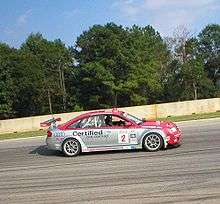
The RS6 was used in the North American SPEED World Challenge GT Series of auto racing for three years - 2002 to 2004, claiming the manufacturers' championship victory successively in all three years.[10] Once again, the special race derivative of the twin-turbo V8 engine was developed and manufactured in the UK by Cosworth Technology (now known as MAHLE Powertrain). However, the 2005 season proved difficult due to performance restrictions imposed on Champion Audi Racing by the Sports Car Club of America (SCCA), with Champion deciding to run a different wheel diameter, and the trade-off was reducing boost pressure.
The RS6 was challenged by a factory-backed Cadillac CTS-V, but was still victorious. Champion Audi Racing decided to pull the RS6 from the series, citing unfair rules and regulations that targeted the dominant Audis.
C6 (Typ 4F, 2008–2010)
| Second generation (C6/4F) | |
|---|---|
_(cropped).jpg) | |
| Overview | |
| Production | 2008–2011 |
| Body and chassis | |
| Body style | 5-door Avant (estate/wagon), 4-door saloon/sedan |
| Platform | Volkswagen Group C6 |
| Related | Audi C6 A6, Audi C6 S6 |
| Powertrain | |
| Engine | Even firing 5.0 L V10 FSI DOHC (BUH) (Lamborghini Gallardo) |
| Transmission | 6-speed ZF 6HP28A tiptronic automatic |
| Dimensions | |
| Wheelbase | 2,846 mm (112.0 in) |
| Length | Avant: 4,923 mm (193.8 in), saloon: 4,928 mm (194.0 in) |
| Width | 1,889 mm (74.4 in) |
| Height | Avant: 1,460 mm (57.5 in), saloon: 1,456 mm (57.3 in) |
| Kerb weight | 2,025 kg (4,464 lb) |
| Chronology | |
| Predecessor | C5 RS6 (Typ 4B) |
| Successor | C7 RS6 (Typ 4G) |
_(cropped).jpg)
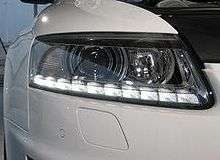
.jpg)
The second-generation RS 6, later called the Audi RS 6 5.0 TFSI quattro (Typ 4F) was based on the Volkswagen Group C6 automobile platform and was launched in September 2007 at the Frankfurt Motor Show. With factory production starting in December 2007, it was available in Europe from the same date, and began to be exported elsewhere in 2009. The total production run of the C6 RS 6 was 8,000 units, with 6,500 of these being Avants and the remainder saloons.[11] The RS 6 was not available in North America, leaving the Audi S6 as the top performing trim there. (The unpopularity of wagons made it unlikely that the RS 6 Avant would be imported, and although it had been rumoured that the RS 6 sedan would be offered in the United States,[12] nothing came of this as the RS 6 importer could not clear US regulations).[13] Production of the C6 RS 6 ended in the third quarter of 2010.[14]
The RS 6's 5.0 L (4,991 cc) V10 engine produced 426 kW (579 PS; 571 bhp) at 6,250 to 6,700 rpm and 650 N⋅m (479 lbf⋅ft) of torque from 1,500 to 6,250 rpm, 52 kW (71 PS; 70 bhp) and 150 N⋅m (111 lb⋅ft) more than BMW's 5.0L V10. As of January 2010, the RS6 was Audi's single most powerful car ever,[15][16] and positioned the car ahead of its closest competitors, the BMW M5 and the Mercedes-Benz E63 AMG in terms of engine output, both of which have naturally aspirated engines. However the estimated price of the RS 6 sedan in 2010 was $160,000 USD (another source quotes $126,000 USD in 2009, making the RS 6 perhaps too expensive for the United States market[11]) which set it apart from the performance variants of other executive cars: the MRSP of BMW M5's was $85,700 USD, of Mercedes-Benz E63 AMG's was $87,700 USD, and of Audi's own S6 was $78,025 USD.[17][18][19][20]
Official performance figures for the Avant: 4.6 seconds for the 0-100 km/h (62.1 mph) sprint, 12.7 seconds 0-200 km/h (124.3 mph), and top speed is electronically limited to 250 km/h (155.3 mph),[21] with a factory option to de-restrict the top speed to 274 km/h (170.3 mph). In standard form, CO2 emissions are rated at 333 g/km. The saloon reaches 0-100 km/h (62.1 mph) in 4.5 seconds.
C6 bodywork and styling
The C6 RS 6 Avant was launched in April 2008, and the four-door saloon/sedan was available from August 2008. Constructed from steel in a monocoque (unibody) design, the RS 6 uses lightweight aluminium for its front wings (fenders) and bonnet (hood).
Visually, the RS 6 differed from the related S6, having flared front and rear wheel arches (fenders), harking back to the original Audi Quattro, to allow for a wider wheel track. It also had no front fog lights to allow for larger frontal air intakes (for the two side-mounted intercoolers (SMICs), and additional radiators). The ten (per side) front light-emitting diode (LED) daytime running lights (DRLs) are located within the main headlamp housing on the RS 6 in order to increase the size of the air intakes, whereas similar LEDs (but five per side) on the related S6 are found adjacent to the fog lamps in the lower front bumper. LED lighting technology was also used in the rear lights. The RS 6 also included adaptive headlights, which swivel around corners in conjunction with steering wheel movements. The facelifted Audi A6, released as a 2009 model, received similar front and rear-end LED lighting styling to that pioneered on the RS 6.
Luggage capacity, measured according to the VDA 'block method' in the Avant ranges from 565 litres (19.95 cu ft), to 1,660 litres (58.62 cu ft).
C6 powertrain
The engine (parts code: 07L, identification code: BUH) of the RS6 was what Audi claimed to be the first all-aluminium alloy even firing 5.0-litre (4,991 cc (304.6 cu in)) 90° V10 twin-turbocharged ("biturbo"), Fuel Stratified Injection (FSI), with a dry sump lubrication system. This engine is related to the naturally-aspirated V10 found in the Audi R8, S6 and S8, and the Lamborghini Gallardo, but the RS 6's engine has around 400 unique parts[11][19].
The engine has four valves per cylinder, with chain-driven double overhead camshafts, and variable valve timing[22] for both inlet and exhaust camshafts. Charged intake air is cooled by two side-mounted intercoolers (SMIC)s. The engine is controlled by two Bosch DI-Motronic[23] MED 9.1.2 engine control units, which act as 'master' and 'slave': two ECUs are required due to the high revs the engine can achieve. It also uses mapped direct ignition system with ten individual direct-acting spark coils, an electronic drive by wire throttle (Bosch "E-Gas"),[24] cylinder-selective knock control, and cylinder bank adaptive lambda control, utilising eight lambda sensors.
A total of seven radiators, and four electric cooling fans are needed to cool the engine and related components under the aluminium bonnet of the RS6.
Drive output passes through a ZF 6HP28A six-speed tiptronic automatic transmission. The gear ratios are: 1st: 4.171, 2nd: 2.340, 3rd: 1.521, 4th: 1.143, 5th: 0.867, 6th: 0.691, with shortened shift times, with "Dynamic Shift Programme" (DSP) and "Sport" mode. It has paddle-shifts mounted behind the flat-bottomed steering wheel, similar in design to the Audi B7 RS 4. The gearbox is set by default, in conventional automatic mode, to delay up-changes during acceleration, and change down earlier to maximise engine braking. Downchanges in all modes of operation include the Powertrain Control Module electronic control unit (ECU) "blipping" the Bosch "E-Gas" drive by wire throttle, for smoother shift changes. The hydraulic torque converter includes a lock-up function in all forward gears, and is able to completely disconnect when the vehicle is stationary, thus saving fuel.
Like all Audi "RS" models, the RS 6 is fitted with Audi's 'trademark' quattro permanent four-wheel drive as standard. This version of the RS 6 uses the latest asymmetric dynamic 40:60 front-to-rear default torque distribution from the Torsen T-3 'automatic torque biasing' (ATB) centre differential. This latest incarnation of the Torsen quattro, first seen in the B7 RS 4, can automatically dynamically apportion up to a maximum 100% torque to the rear axle, or up to 80% to the front, dependent on traction conditions.
The front and rear final drives are conventional "open" differentials (ratio 3.317), and use the Audi "Electronic Differential Lock" (EDL). EDL is a part, or "function", of the Bosch ESP 8.0 Electronic Stability Programme,[8] which also includes "Anti-Slip Regulation" (ASR) traction control system. EDL does not 'lock' the differential in a traditional sense, but uses electronics to compare the speeds of the two wheels on an axle, and brakes any wheel that is sensed to have lost traction (by rotating faster than the opposite wheel, beyond normal accepted deviations). This braking of a slipping wheel has the effect of transferring torque across the axle to the other wheel, which is assumed still to have traction.
C6 steering and suspension
Like the previous RS6 and the B7 RS 4 this generation of RS 6 includes Audi's "Dynamic Ride Control" (DRC) Sports suspension system. The system is mainly mechanical, using a pump to provide additional pressure in the diagonally linked dampers (shock absorber) during cornering, to counteract rolling and pitching. The system can dynamically adjust the stiffness at each damper constantly to maintain both a comfortable ride and high grip. On this version, it has a three-way level control, selectable from the Multi Media Interface controls.
The steering system includes rack and pinion speed-dependent "servotronic" power steering, with a ratio of 12.5, and a turning circle of 12.2 metres.
C6 brakes, wheels and tires
The standard brakes on the RS 6 are cross-drilled, radially vented and floating iron discs. At the front they are 390 millimetres (15.35 in) diameter and 36 mm (1.417 in) thick, clamped by gloss black six-piston fixed Brembo monoblock alloy calipers incorporating the "RS" logo, and at the rear they are 356 mm (14.02 in) diameter and 28 mm (1.102 in) with black single-piston floating calipers and an integrated electro-mechanical parking brake linkage. The parking brake serves doubles as a full emergency brake whilst the car is in motion, by applying maximum braking effort to all four wheels, resulting in activating the Anti-lock Braking System (ABS).
Optional "Audi ceramic" Carbon fibre-reinforced Silicon Carbide (C/SiC) composite front brakes are available, only with 20-inch wheels, which use 420 mm (16.54 in) diameter by 40 mm (1.575 in) thick drilled, vented, and floating SGL Carbon composite discs, with grey painted eight-piston fixed Alcon monobloc alloy calipers with the "Audi ceramic" logo.
Irrespective of the type of disc construction, all brake discs are mounted via high strength steel mounting pins which connect the 'working' surface of the disc to lightweight alloy disc hubs.
A specifically 'tuned' "sport-biased" Bosch ESP 8.0 Electronic Stability Programme is standard, and includes Anti-lock Braking System (ABS) and Electronic Brakeforce Distribution (EBD), and Brake Assist (BA). This ESP system has three user-selectable settings: "ESP-on" - the standard default full protection mode, "ESP-sportmode" (which turns off the ASR and EDL traction functions), and "ESP-off" (which fully disables all 'stability' and 'traction' related functions).
Standard wheels (in the UK) are 9.5Jx20-inch '5-segment-spoke' design alloy wheels running on 275/35 ZR20 102Y XL (eXtra Load) tyres (rated at 850 kg (1,874 lb) per tyre), with official supplies being either Pirelli P-Zero Rosso or Dunlop SP SportMaxx GT. No-cost options are 9.5Jx20 '7-arm double spoke' design (identical style to B7 RS 4), or 9Jx19-inch '10-spoke' design alloys with 255/40 ZR19 Michelin Pilot Sport PS2 tyres.
C6 other notable features
- Digital Audio Broadcasting (DAB) digital radio tuner with DVD-based satellite navigation and Multi Media Interface (MMI), with optional hybrid digital/analogue TV tuner.
- Solar sunroof operating the air con whilst the vehicle is stationary and the engine is turned off
- Rear window and rear side window manual sun blinds
C7 (Typ 4G, 2013–2018)
| Third generation (C7/4G) | |
|---|---|
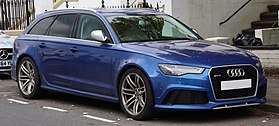 Audi RS6 Avant quattro (C7, United Kingdom) | |
| Overview | |
| Production | 2013–2018 |
| Body and chassis | |
| Body style | 5-door Avant (estate/wagon) |
| Platform | Volkswagen Group C7 |
| Related | Audi C7 A6, Audi C7 S6 |
| Powertrain | |
| Engine | 4.0 L (3,993 cc) V8 TFSI twin-turbo DOHC (see list of Volkswagen Group petrol engines) |
| Transmission | 8-speed tiptronic automatic |
| Dimensions | |
| Wheelbase | 2,915 mm (114.8 in) |
| Length | 4,991 mm (196.5 in) |
| Width | 1,986 mm (78.2 in) |
| Height | 1,461 mm (57.5 in) |
| Kerb weight | 1,950 kg (4,299 lb) |
| Chronology | |
| Predecessor | C6 RS6 (Typ 4F) |
| Successor | C8 RS6 (Typ 5G) |
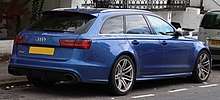
Audi revealed the details of the RS 6 Avant on December 5, 2012.[25] Its twin-turbo 4.0 L (3,993 cc) TFSI V8 engine develops 412 kW (560 PS; 553 bhp) at 5700-6600 rpm and 700 N⋅m (516 lbf⋅ft) of torque at 1750-5500 rpm.[26] This will enable the RS 6 Avant to accelerate from 0 to 100 km/h (62.1 mph) in 3.9 seconds. The top speed is limited to 250 km/h (155.3 mph) by default. By adding the optional Dynamic or Dynamic Plus package, this top speed is increased to respectively 280 km/h (174.0 mph) or 305 km/h (189.5 mph). Audi claims an average fuel consumption of 9.6 L/100 km (29.4 mpg‑imp; 24.5 mpg‑US)[26] and CO2 emissions of 223 g/km.[26] In order to accomplish this, Audi has added a start-stop system and a cylinder on demand system. The RS 6 Avant is offered with an 8-speed tiptronic transmission.
C7 RS6 Performance
The RS6 Avant Performance is powered by the same 4.0-litre TFSI twin-turbo V8 engine as the standard RS6, [27] but with the help of a retuned ECU mapping, it increased power output to 605 PS (445 kW; 597 bhp) at 6100-6800 rpm and increased torque to 750 N⋅m (553 lbf⋅ft) at 2500-5500 rpm.[28] While the top speed remains limited to 250 km/h (155.3 mph), or 305 km/h (189.5 mph) with Dynamic Plus package, the 0 to 100 km/h (62.1 mph) time has been reduced to just 3.7 seconds at from 0 to 200 km/h (124.3 mph) in 12.1 seconds. Despite the improved performance, the fuel economy and CO2 are unchanged from the standard RS6 Avant.
C8 (Typ 5G, 2019–Present)
| Fourth generation (C8/5G) | |
|---|---|
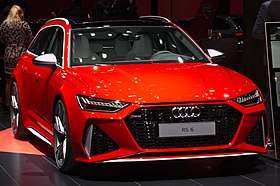 | |
| Overview | |
| Production | 2020-present |
| Body and chassis | |
| Body style | 5-door Avant (estate/wagon) |
| Platform | MLBevo |
| Related | Audi C8 A6, Audi C8 S6 |
| Powertrain | |
| Engine | 4.0 L (3,996 cc) V8 TFSI twin-turbo DOHC (see list of Volkswagen Group petrol engines) |
| Transmission | 8 speed automatic |
| Dimensions | |
| Wheelbase | 2,929 mm (115.3 in) |
| Length | 4,995 mm (196.7 in) |
| Width | 1,951 mm (76.8 in) body 2,120 mm (83.5 in) with mirrors |
| Height | 1,460 mm (57.5 in) |
| Curb weight | 2,150 kg (4,740 lb) |
| Chronology | |
| Predecessor | C7 RS6 (Typ 4G) |
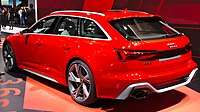
As with the previous generation, the new RS6 is powered by a 4.0-litre twin-turbo TFSI petrol engine, now boosted by a 48V belt alternator/starter mild-hybrid system, which can recover up to 16bhp. The engine also utilises a cylinder-on-demand system that can shut off half of its cylinders to boost fuel economy.
The powertrain produces 600ps (591bhp) – up from 560ps (552bhp) of the previous generation, but slightly below the 605ps (596bhp) offered by the 2016 Performance variant – with 590lb ft available between 2100rpm and 4500rpm.
The acceleration to 100 km/h (62 mph) takes 3.6 seconds and 200 km/h in 12 seconds. As standard, top speed is limited to 250 km/h, with a further two levels courtesy of optional packs – the Dynamic package allows 280 km/h, while the Dynamic package plus grants even more headroom for a maximum of 305 km/h. The C8 is first RS 6 Avant to have the hybrid drivetrain, utilising Riemen-Starter-Generator and 48-volt electrical system.[29] The quattro system has power distribution with 40% for front and 60% for rear. The system can adjust the power distribution up to 70% for front and to 85% for rear if needed. The adaptive suspension system is 20 mm lower than standard A6 and can lower the vehicle further 10 mm during the high speed driving or can raise the ride 20 mm at low speed. The Drive Select function gains configurable RS1 and RS2 modes, which are activated by an ‘RS mode’ button positioned on the steering wheel. As well as adjusting the engine and handling responses, they also enable bespoke information on the Virtual Cockpit system.
The new RS 6 Avant will also be sold in the US for the first time. The closest equivalent of RS 6 Avant in the past was the RS 7 Sportback.[30]
See also
- Audi Sport GmbH
- Audi S and RS models
- Audi A6
- Audi S6
- Audi S4
- Audi RS4
- List of vehicle speed records
References
- "2010 Audi RS6 Avant". Car and Driver. Retrieved 24 January 2015.
- "Mercedes E55 AMG". Evo. Retrieved 24 January 2015.
- "2003 Audi RS 6 vs. BMW M5, Jaguar S-type R, M-B E55 AMG". Car and Driver. Retrieved 24 January 2015.
- Bosch Automotive Technology Manifold injection: Method of operation
- Bosch Automotive Technology Ignition
- Bosch Automotive Technology Motronic for manifold-injection engines
- Bosch Automotive Technology Traction Control System TCS
- Bosch Automotive Technology Electronic Stability Programme ESP
- Bosch Automotive Technology Antilock Braking System ABS
- Audi.com "2004 - Touching" (PDF). (1.98 MB)
- Davis, Matt (2008-09-16). "2009 Audi RS6 Sedan First Drive on Inside Line". Insideline.com. Retrieved 2012-03-31.
- Audi RS6 Sedan unveiled: details and photos - PaulTan.org blog.
- "No Audi RS6 imports for North America". Worldcarfans.com. Archived from the original on 18 September 2010. Retrieved 2010-09-17.
- "Audi RS6 production coming to an end". Worldcarfans.com. Archived from the original on 24 September 2010. Retrieved 2010-09-17.
- Audi UK - The New Audi RS6 - Pricing and Specification Guide, Edition 1. 02/08
- Audi UK - Audi RS6 - Pricing and Specification Guide, Edition 2. 05/08
- "2009 Audi S6 Audi S6 Car Buying Guide at CARandDRIVER.com- 2009 Audi". Buyersguide.caranddriver.com. Archived from the original on 2012-07-08. Retrieved 2011-08-02.
- "2009 Mercedes-Benz E63 AMG Reviews, Pictures and Prices | U.S. News Best Cars". Usnews.rankingsandreviews.com. Archived from the original on 2011-08-17. Retrieved 2011-08-02.
- "2010 Audi RS6 Avant - First Drive Review". Car and Driver. Archived from the original on 18 September 2010. Retrieved 2010-09-17.
- Chris Harris. "Europe's Fastest Wagons: Audi RS4, BMW M5, and Mercedes-Benz E63 AMG - New Car, Truck, and SUV Road Tests and Reviews - Automobile Magazine". Automobilemag.com. Retrieved 2012-03-31.
- "Audi RS6 Electronic Limiter". usedcarsworld.co.uk. Archived from the original on 2013-12-03. Retrieved 2012-07-26.
- Bosch Automotive Technology Variable valve timing direct gasoline injection
- Bosch Automotive Technology DI-Motronic for direct gasoline injection
- Bosch Automotive Technology Electronic throttle control (ETC/EGAS) for direct gasoline injection
- Audi MediaServices Groundbreaking performance: The new Audi RS 6 Avant
- "2014 Audi RS 6 Avant". Carfolio.com. 2018-08-05. Retrieved 2018-08-16.
- http://www.autoexpress.co.uk/audi/rs6/93201/audi-rs6-avant-and-rs7-performance-editions-unveiled-with-597bhp
- "2015 Audi RS 6 Avant performance". Carfolio.com. 2018-08-05. Retrieved 2018-08-16.
- Peter Fischer (21 August 2019). "Mild-Hybrid-V8 für den neuen RS 6!" (in German). Auto Bild.
- Justin T. Westbrook (20 August 2019). "The 591 HP 2020 Audi RS6 Avant Is Coming To America (Updated)". Jalopnik.
External links
| Wikimedia Commons has media related to Audi RS6. |
- Audi UK RS models
- The Torque Report - 2008 Audi RS6 Avant Press Release + photos
- Audi RS6 international community